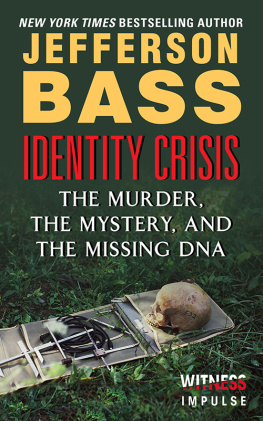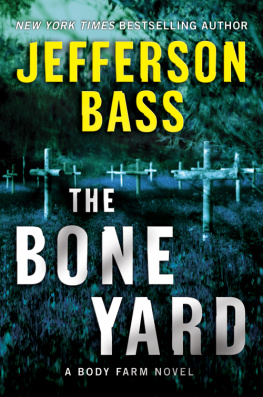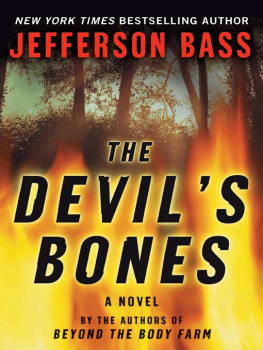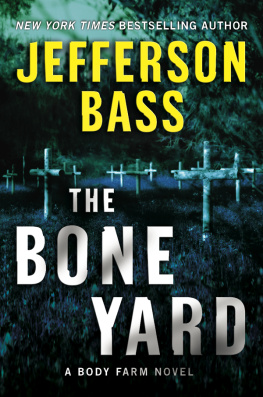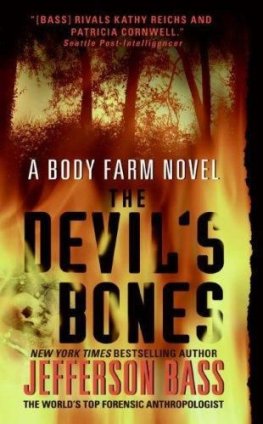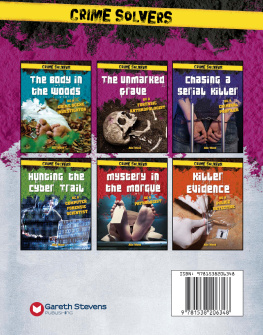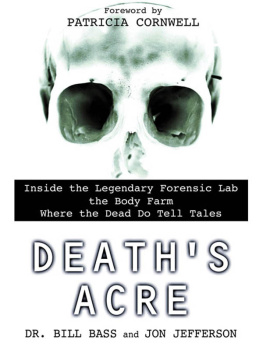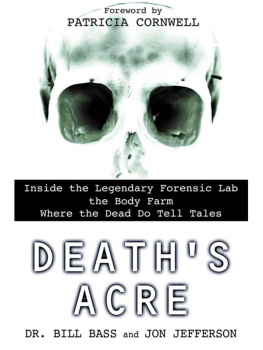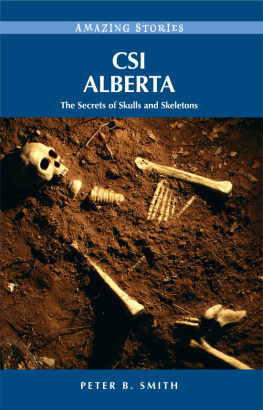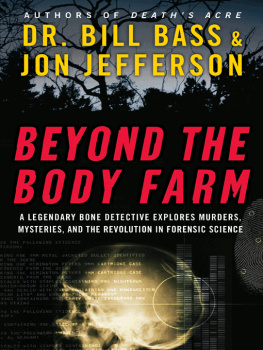
Identity Crisis
The Murder, the Mystery, and the Missing DNA
JEFFERSON BASS

For Joanna Hughes, Graciela Cabana, David Ray, and Jason Eshleman, whoto our immense surpriseworked case-changing, mystery-solving miracles
Contents
Reopening a Coffin,
Reopening a Case
F ORTY MILES NORTHWEST of Knoxvilledeep in the heart of hardscrabble coal countryRedoak Mountain nestles amid the peaks and valleys of the Cumberlands, an Appalachian range angling through Tennessee and up along the Kentucky-Virginia border. As mountains go, Redoak isnt particularly noteworthy. It tops out at 3,200 feet, less than half the height of the loftiest peaks in the nearby Great Smoky Mountains. Yet somehowthrough some remarkable, unfortunate confluence of geology, bulldozing, and pavingthe narrow switchback road I found myself navigating one muggy summer morning seemed to hang about 3,199 of those 3,200 feet above the steep, wild valleys below. My view of the valleys was clear and unobstructed. It was also more than a little unnerving, because the invention known as the guardraila common sight along many mountain roads in Tennesseedid not seen to have made its way yet into these perilous parts.
Even the place names out here, scarcely a stones throw from my ivory tower at the University of Tennessees Anthropology Department, harked back to an earlier, wilder world: Bearwallow Branch. Backbone Ridge. Graves Gap. One-room churches and tiny cemeteries seemed to outnumber the houses, unless you counted the handful of mobile homes, which appeared to have been airlifted into their notches in the steep hillsides. The route we were following over Redoak Mountain (we being writer Jon Jefferson, graduate student Kate Spradley, and I) was far off the beaten track. If I hadnt already noticed that fact on the high, hairpin curves, Id have surely realized it when the guy we were followinga local who supposedly knew where we were goinggot lost, taking us ten miles in the wrong direction before reversing course and turning up a side road.
The threadbare fabric of civilization clinging to the slopes and hollows of Redoak Mountain might logically raise the question, Why? Why bother carving roads and snaking trailers into these remote backwoods areas? The answer came from the heavy trucks groaning down the grades. The Cumberlands might be poorly settled, but theyre richly mineraled, and the trucksladen with strip-mined coal for the power plants of the Tennessee Valley Authoritywere an intimidating reminder of the reason for most of the roads... and perhaps many of the gravestones.
On this morning in August 2005, I was threading my way over Graves Gap and down the north side of Redoak Mountain to exhume a grave in a family cemetery in a remote, rugged corner of Anderson County. Three months earlier Id gotten a call from a young woman named Michelle Atkins. A recent UT graduate, Michelle had heard me guest-lecture in her chemistry class, where I talked about forensic anthropology, my postmortem-research facility called the Body Farm, and a few of the cases I had worked during nearly five decades as a bone detective. When she phoned, Michellean avid fan of the forensic drama CSI asked if I might be able to help answer a question that had been troubling her family for more than twenty-five yearsever since the disappearance and apparent murder of her grandmother: Was the skeleton that had been found and identified as her grandmothers, and later buried in the family cemetery, really who the authorities said it was? Or might the investigators have made a mistake in their eagerness to close the case and to put an end to the familys repeated inquiries?
It sounded fascinating. Ill be happy to help if I can, I told Michelle. She gave me a bit more background, and a few days later one of her aunts, Frankie Davisthe youngest daughter of the woman in questioncalled from Texas to offer more details. The story Michelle and Frankie told me was this: Leoma PattersonMichelles grandmother, and the mother of Frankie Davis and three other grown childrenwent missing from the town of Clinton, Tennessee (about twenty miles north of Knoxville), one night in October 1978. She left a bar with two mena father and sonand was never seen again. Five months later some kids playing in the woods beside Norris Lake found part of a human skeleton. Animals had scattered or eaten many of the bones; the ones remaining on the wooded slope included a skull, some ribs, a couple of long bones, and part of the spine. The hair mat, which had sloughed off the skull as the scalp decayed, lay nearby as well, along with a tattered dress and a turquoise ring.
The remains had been examined by Dr. Cleland Blake, a medical examiner who served several East Tennessee counties. The bones had come from a middle-aged white woman, Dr. Blake concluded. Given that Leoma Patterson was the only missing person in the area who fit that profile, he tentatively identified them as hers. Frankie Davisbrought to the Campbell County courthouse by Special Agent David Ray, of the Tennessee Bureau of Investigationidentified the turquoise ring as Leomas. It wasnt an airtight identification, but it was the best they could do, given the condition of the remains and the lack of a more definitive means of identification. Leoma Patterson had no fingerprints on file, but even if there had been prints on file, the remains had no fingerprintsno fingers at all, nor even handsthanks to the ravages of time and the teeth of animals. Leoma Patterson also had no dental or medical X rays on file, nor were there other identifying skeletal features (healed fractures, for example) that her family could recall.
The mystery of how Leoma Patterson had ended up dead, dumped on a wooded hillside, remained unsolved for more than five years. Meanwhile, Dr. Blake had held onto the bones, against the possibility that the case might take a turn or investigators might get a break someday. And indeed, both of those events came to pass: In 1985 a great-nephew of Leoma Pattersons, Jimmy Ray Maggardthe younger of the men shed left the bar with that nightconfessed to killing her. They had quarreled over a drug deal, he said, and Maggard, nineteen at the time of the quarrel, had struck his fifty-six-year-old great-aunt with a tire iron. Maggard pleaded no contest to voluntary manslaughter, the case was closed, and the skeletal remains were finally buried in September 1985, beneath a heart-shaped granite headstone inscribed PATTERSON .
But Leomas childrenthree daughters and a sonwere never completely convinced by the medical examiners report, never entirely sure that the identification was correct. Over the next two decades they would often wonder whether those really were their mothers bones in that hillside grave. Eventually, as their own childrenLeomas grandchildrengrew up, a new generation heard the story of Leomas death, and heard the nagging doubts about the identification. By the time Leomas granddaughter Michelle listened to me lecture in chemistry class, shed heard the question countless times over the years: Is it really her?
Meanwhile, during the years since Leomas disappearance, forensic scienceespecially techniques for human identificationhad changed dramatically, thanks to a revolutionary new tool in to the forensic toolbox: DNA testing.
The DNA revolution had begun half a century before, in 1953, when two scientists at Englands Cambridge UniversityJames Watson and Francis Cricksolved a puzzle that had baffled geneticists and chemists for decades: What was the structure of the immense protein molecule that encoded every persons unique genetic fingerprint, developmental blueprint, and biochemical operating instructions? The answer, which Watson and Crick deduced from micrographs taken by Rosalind Franklin as she fired X rays through crystallized specimens of the molecule, was elegant but surprisingly simple. That protein molecule, deoxyribonucleic acidcommonly known simply (and mercifully!) as DNAwas shaped like a microscopic ladder three billion rungs high, its uprights tightly twisted into the corkscrew double helix, which is now one of the most familiar shapes on Earth.
Next page
